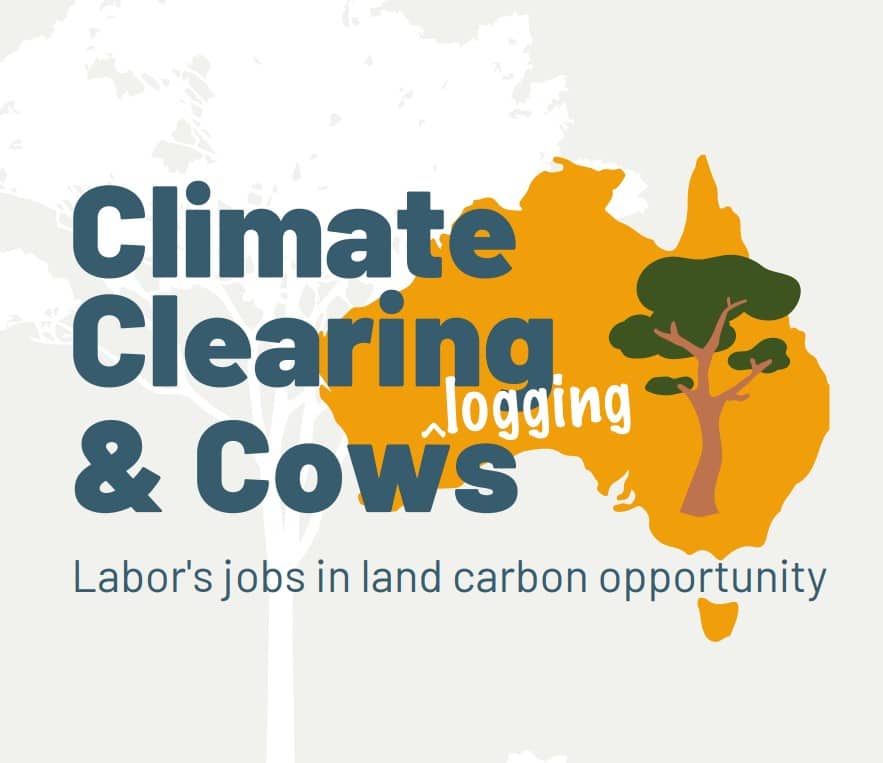Measuring What Matters, a new Federal Framework to track progress across 50 indicators released on 20 July, had one indicator that read negative progress.
It was trust in the political process.
The National media reported that the Federal Treasurer had used old data.
When it concerned trust in the Federal political process, no one reported that the data was old.
An internal ALP lobby group called LEAN and its interaction with the Federal ALP exemplify truthfulness in the political process.

LEAN is an acronym for the ‘Labor Environment Action Network’.
LEAN says theirs is a network that pushes what they consider to be agenda that ensures the environment is central to the future.
The 49th ALP Federal National Conference will be held in Brisbane from Thursday, 17 to Saturday, 19 August 2023.
Over 2000 people will be attending.
LEAN has issued a six-page glossy booklet to all ALP Branches calling for identical motions to be passed against deforestation in Australia and cows “farting and burping”, seriously.
Each ALP Branch is asked to submit a selfie holding the booklet.
This is a slick political operation using traditional and digital communications, and over 300 branches have responded.
There is one problem with all this.
Much of what is written in the booklet is wrong or very selective reporting.
Indeed, it is an environmental network rounding up the same misinformation peddled for years, reflecting none of the Government’s reports and actions.
The list of errors in the claims about forestry without examining the cattle issue is lengthy.
Claim: Forestry is treated as both softwood and hardwood; no distinction is made despite softwood being plantation and hardwood being largely native and some plantation.
Response: There are two industries here that use different types of trees.
Claim: Forestry harvesting is counted as land clearing.
Response: Forestry replants and regenerates trees. It is the industry’s future. Forestry is not land clearing or deforestation, which is defined as permanent land use change.
Claim: There is a continual footnoting of international reports.
Response: There are Australian reports that look at Australian forests but contradict the material in the LEAN brochure. There are Government Reports that warrant citations on Australian native forests.
Claim: All timber should be in plantations.
Response: In reality, this means finding available land that is usually already used for other agricultural operations or clearing vast areas of new land to replant Australian hardwoods. They cannot be serious.
Claim: Carbon is stored in forests so do not harvest them.
Response: Carbon sequestration is a complicated scientific issue. But commonsense does help. What is not disputed is carbon is stored in trees. Growing trees sequester carbon. Mature trees do not sequester significant amounts of carbon because they have stopped growing. Young trees are constantly needed if trees are to store carbon continually.
Claim: Native forest hardwood is mostly used in woodchip products.
Response: Woodchips are one of the lowest-value products from a forestry operation. There is a hierarchy of use for harvested timber which requires the highest value use first – this is never published by environmental organisations because it does not suit their narrative. The list includes hardwood flooring, furniture, building cladding, railway sleepers, mining timbers, constructions timbers, specialists’ timbers for interior use, and utilities such as power poles, bridges, wharves, girders and piles. They all carry sequestered carbon after harvest and beyond. The harvested tree is replaced with one sequestering carbon as it grows. This information is in GovernmentGovernment reports.
We will see what the ALP National Conference does with the LEAN push.
There are many interests in play.
The CFMEU has members in Tasmania and NSW that are in the forestry industry.
The Victorian Government’s cessation of native forestry is turning into a dog’s breakfast.

The flow of policy issues and the impact in unforeseen quarters without the public funds to fully compensate industry and workers or correct policy impacts.
Similarly, the WA closure is running into trouble with an inadequate compensation package.
The forests that the forest industry cannot sustainably harvest can be bulldozed for mining – go figure.
The Albanese Government should be keen not to impact the industry as its sets up a federal election with its overarching objective to secure sufficient soft Liberal votes to plan for a possible third term.
This is achievable by winning Coalition seats with a reduced conservative vote and the preference flow giving the seat to the ALP.
Some TEAL seats might be in for a similar play.
There are key seats in the coming contest in Tasmania.
The right wing of the federal ALP would not be keen to see the left wing obtain such an advantageous policy change – nor would the left of the ALP in Tasmania.
In Canberra and clearly, in NSW, most of the Liberal party progressives have drunk the ‘kool-aid’ of the environmental movement’s propaganda on native forestry.
Only Tasmanian MPs kept the federal party from becoming a quasi-left-wing ALP on native forestry.

In NSW, many of the Liberal moderates in Government were already operating with the environmentalists in the public service and private sector.
The National Party purportedly ran the blocker.
But, today, most of the Nationals in NSW and Canberra only pay lip service to the interests of native forestry.
It seems that it has become all too difficult for them and might cause issues with their re-election.
After all, with most politicians, it is always about them!
However, their challenge is the native forestry industry knows who their real friends are.





